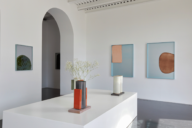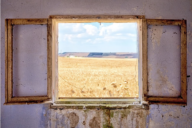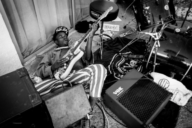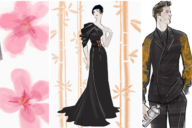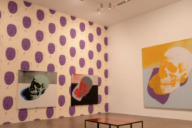PAUL THOREL: INSTALLATION FOR MADRE MUSEUM IN NAPLES
French-Italian artist Paul Thorel’s freshly presented mosaic for the courtyard of MADRE museum in Naples, a commission of their acquisitions program ‘Per_Forming a Collection: For an Art Archive in Campania’.
For MADRE, Thorel has decided to work for the first time with mosaic, paying homage to this Southern Italian tradition that has been used since the Greco-Roman age. Thorel’s Passaggio della Vittoria (Victory Passage) is a large-scale mosaic of over 150 square meters across the four walls of the passage connecting the Main Courtyard with the Sculpture Courtyard.
After visiting the studio of artist Carla Accardi in Rome in 1974 Paul Thorel (London, 1956) began to explore the creation of digital images at the Institut National de l’Audiovisuel in Paris in 1979. In the following years, he dedicated himself to experimental projects, collaborating with TV production centres, computer industries and universities, realising projects for cinema, theatre and advertising. The accidental distortions of the image and the so-called ‘snow effect’ – produced by meteorological turbulences that cause the disrupted reception of the audiovisual signal on the television screen and require the adjustment of the television antenna – contributed to his definition of a mobile and immersive gaze. His fascination with the alteration of the image at the beginning of the eighties led Thorel to be one of the first European artists to explore digital technologies in the photographic practice, applying himself to the digital treatment of the image, to its decomposition into lines, shadows and indistinct traits. Since 1982, Thorel has published the results of his ongoing research in international photography magazines such as Aperture, Originale, Zoom and Photographies Magazine, as well as in various Italian newspapers and weeklies.
Starting from a real image, the artist breaks down the recognisable image into horizontal, lateral and oblique lines, creating a rarefied and indefinite landscape. Only a ‘distant’ and visionary gaze, at odds with the hyper-realism of the photographic medium, can recompose the image, recognising in a succession of vibrating shading effects, real human figures, faces, immersed within their contexts. These include portraits, such as those presented in exhibitions at the Castello Svevo in Bari (2002), the MANN-Museo Archeologico Nazionale in Naples (2003) and the Institut Français de Florence in Florence (2009).
‘Passaggio della Vittoria’, 2018:
‘If you get too close, you don’t see’. The distance of the vision, the suggestion of the gaze, the primitive intuition of the figure, whether it is a face or a landscape, all constitute the figurative vocabulary of this very personal abstraction: those that at first glance seem to be just successions of decomposed digital strokes, recompose themselves in a transversal way, making something unexpected appear before our eyes: the horizon of a subliminal and hypothetical figuration. Perception and intuition, transversality and obliquity, television and computer movement, as opposed to photographic stasis, are in fact fundamental concepts in Thorel’s work. ‘The oblique look is a look that escapes and that leads you to put yourself at the side of things so as to lose that lucidity that would give no room to chance. Not being too lucid, losing concentration, perceiving rather than looking, giving way to apparitions, are among the elements of my research and are an integral part of my work, tools on a par with the camera and the computer’. Greta Travagliati explains further: ‘By harmoniously combining abstract and figurative construction, Thorel’s research represents a moment of synthesis in experimentation and reflection on the role of photography in contemporary culture’. Transit, from digital decomposition to the real recomposition of the gaze, the ‘passage’ from the absence of vision to intuition, are the interpretative elements that, in Passaggio della Vittoria, the site-specific installation created specifically for MADRE, are manifested in their most emblematic meaning and constitute the most complete work created by the artist to date.
The large glazed porcelain stoneware mosaic obtained by pressing, laid on the four walls of the passage that connects the central courtyard of the museum to the sculpture courtyard, is inspired by the white mosaic that covers the vault of the Victory Gallery. This monumental Fascist gallery, which is still important in Naples as it joins two key districts of the city, was completed in 1929 and features a 609-metre-long driveway that connects the city from east to west, with specular entrances and terminals between Via Acton at the front of Molo Siglio, at the foot of Palazzo Reale, the physical limits of the San Ferdinando district, and the heart of the Rione della Vittoria, precisely at the historic intersection of Chiatamone, Giorgio Arcoleo and Domenico Morelli Streets. Thorel’s installation takes inspiration from the Gallery, which was one of the first major urban works in terms of its size and showcased technological solutions adopted by the Fascist regime, reflecting a work as monumental as that created by the artist for MADRE Museum: a mosaic of over 150 square metres, made with 1,832,400 tiles, each 1×1 cm in length and decorated with digital machines. The set of shapes, segments, horizons and colours set on a white background, accompany the visitor in the passage from one point to another during their visit. As in the series ‘Tapestries’, the vision starts from hundreds of photographs of sea views.
A recurrent theme in the work of Thorel since the eighties, it connects the beloved city of Naples where he lives to the island of Panarea, which welcomes the artist in moments of pause and reflection, allowing an opportunity to regain possession of the pixel, no longer on the screen but on the wall surface. Through the shape of the mosaic, Thorel gives us back, in a 1×1 cm porcelain tile, the materiality, and therefore the reality, that those small luminous points of the digital image, together with millions of other pixels, evoke: the rays of the sun, the reflection of light on the Neapolitan palaces with their variegated colorations, the silver ripple of the blue waters, the iridescent colour of the arboreal and floral elements… the magnificence of a look that selects, memorises, decomposes, recomposes and reconstructs the representation of reality around and within us.
Paul Thorel, Passaggio della Vittoria, 2018
MADRE,
Museo d’Arte Contemporanea Donnaregina
Via Luigi Settembrini,
79, 80139 Naples,
Italy
23 June – ongoing



